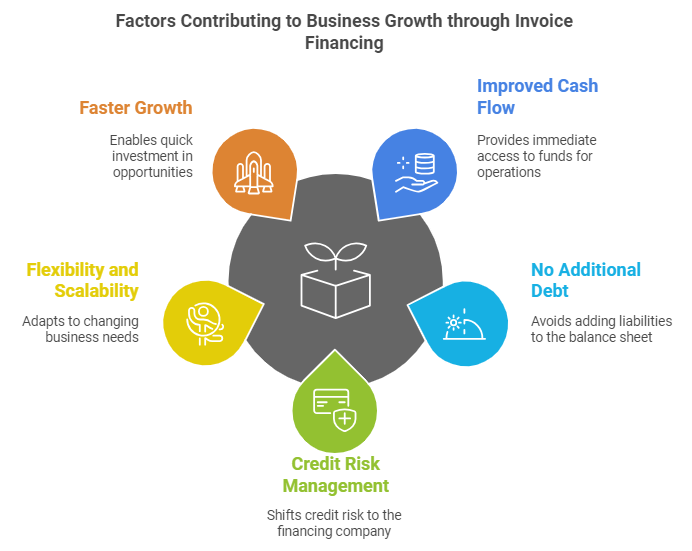Struggling with cash flow issues due to unpaid invoices? Invoice financing might be the solution you need. This financial strategy allows businesses to unlock the cash tied up in their outstanding invoices, providing immediate working capital to manage operations and invest in growth.
In this article, we will take an in-depth view of what invoice financing is and how it works. Additionally, we will also explore the various steps involved in obtaining, its potential benefits and drawbacks, as well as its eligibility criteria.

What is Invoice Financing, And How Does it Work in Philippines

Invoice financing is a financial solution that allows businesses to unlock the cash tied up in their unpaid invoices. This method helps companies improve their cash flow, manage expenses, and invest in growth opportunities without waiting for clients to pay their invoices.
Here’s a detailed step-by-step explanation of how it works in the Philippines -
1. Invoice Creation and Submission
When a business in the Philippines delivers goods or services to a client, it issues an invoice outlining the payment terms, which typically range from 30 to 90 days. This invoice is a promise of payment from the client.
Philippine businesses often face delays in receiving these payments, which can create cash flow challenges. So, to eliminate this inconvenience, businesses can choose to finance these invoices by partnering with a financial institution or an invoice financing company.
2. Selecting a Financing Company
The next step involves selecting a reputable invoice financing company in the Philippines. Businesses should research and compare various providers to find one that offers favorable terms and aligns with their financial needs.
Some of the crucial factors to consider include the advance rate, fees, and the company’s reputation.
Once a suitable provider is selected, the business must apply along with the unpaid invoice since the application process usually involves providing information about the business, its clients, and the outstanding invoices.
3. Advance on Invoice Value
Upon approval, the financing company advances a significant portion of the invoice value to the business, usually between 70% to 90%. This immediate infusion of cash helps the business manage its operational expenses, such as payroll, inventory purchases, and other overhead costs.
It is worth pointing out that the advance percentage and the terms can vary based on the financing company’s policies and the creditworthiness of the business’s clients.
4. Collection of Invoice Payment
After advancing the funds, the financing company takes over the responsibility of collecting the invoice payment from the client, meaning that the client will now pay the financing company directly.
This arrangement relieves the business of the burden of following up on payments and allows it to focus on its core operations. Moreover, the financing company typically maintains a professional approach to ensure the client relationship remains positive.
5. Final Settlement
Once the client pays the invoice in full, the financing company releases the remaining balance to the business after deducting the financing fees. These fees can vary but generally include a service fee and an interest charge based on the duration the invoice remained unpaid.
The final settlement provides the business with the remainder of the invoice value, minus the agreed-upon fees, to complete the transaction.
Also Read: How Does A Bridge Loan Work For a Small Business?
Types of Invoice Financing Available in Philippines
Need to boost your cash flow quickly? Invoice financing offers various solutions for businesses in the Philippines to convert their unpaid invoices into immediate cash.
Understanding the different types of invoice financing available can help you choose the best option for your business needs. Here, take a look at the different types of invoice financing you can avail in the Philippines -
1. Invoice Factoring
Invoice factoring involves selling your unpaid invoices to a factoring company at a discount. In this arrangement, the factoring company advances a percentage of the invoice value, typically between 70% to 90%, providing immediate working capital.
The factoring company then takes over the collection process from your clients. Once the client pays the invoice, the remaining balance, minus the factoring fee, is paid to you.
This method not only improves cash flow but also offloads the credit management responsibilities to the factoring company. However, it’s essential to consider the costs involved and the potential impact on customer relationships.
2. Invoice Discounting
Invoice discounting is similar to factoring but with a key difference: your business retains control over the collection process.
In this setup, a financial institution provides a loan against the value of your unpaid invoices, and you receive a significant portion of the invoice value upfront. At the same time, your business continues to collect payments from customers.
Once the invoice is paid, you repay the loan, including any fees and interest. Invoice discounting keeps the customer relationship management in-house and can be more discreet, as clients are unaware of the financing arrangement.
3. Selective Invoice Financing
Selective invoice financing, also known as spot factoring, allows businesses to choose specific invoices to finance rather than committing their entire accounts receivable. This flexibility enables you to manage cash flow more strategically by targeting high-value or long-term invoices for financing.
A financial institution or factoring company provides an advance on the chosen invoices, and the collection process can be managed either by your business or the financing company, depending on the agreement.
This option is beneficial for businesses that only need occasional financing or want to avoid ongoing fees associated with traditional factoring agreements.
4. Reverse Factoring
Reverse factoring, or supply chain financing, involves a financing arrangement initiated by the buyer rather than the supplier. In this scenario, the buyer works with a financial institution to guarantee payment to the supplier.
Once the supplier delivers the goods or services and issues an invoice, the financial institution pays the supplier immediately, often at a discount. The buyer then repays the financial institution at the invoice due date.
Reverse factoring benefits suppliers by providing immediate payment and benefits buyers by potentially negotiating better terms with suppliers due to the guaranteed payment arrangement. This type of financing strengthens supplier relationships and ensures a more stable supply chain.
Also Read: Understanding Working Capital: How to Calculate and its Importance
Important Steps to Obtain Invoice Financing in Philippines - Guide For Filipino Entrepreneurs
Invoice financing can be a powerful tool for Filipino entrepreneurs looking to unlock the capital tied up in unpaid invoices.
Here’s a step-by-step guide to help you navigate the process of obtaining invoice financing in the Philippines -
1. Evaluate Your Financing Needs
Start by assessing your business’s financial needs by determining how much working capital you require and for what purposes. This evaluation helps you understand whether invoice financing is the right solution and how much funding you should seek.
The best way to approach this is by considering your cash flow patterns, invoice values, and payment terms from your clients.
2. Research Invoice Financing Providers
Next, conduct thorough research on invoice financing providers in the Philippines by looking for companies with good reputations, competitive terms, and a history of working with businesses similar to yours.
Moreover, compare the services, fees, advance rates, and customer reviews of multiple providers, as this research will help you identify the best type of invoice financing to match your business’s needs.
3. Prepare Required Documentation
Gather all necessary documents before approaching financing companies. Typically, you will need copies of your unpaid invoices, proof of delivery or service completion, financial statements, business registration documents, and information about your clients.
This is an important step in the process, as having these documents ready will streamline the overall application process and improve your chances of approval immensely.
4. Submit Your Application
Once you’ve selected a suitable provider, submit your application along with the required documentation. Additionally, be prepared to provide detailed information about your business, your clients, and the invoices you wish to finance as well..
A complete and accurate application will speed up the approval process and demonstrate your business’s reliability.
5. Negotiate Terms and Fees
After your application is reviewed and approved, discuss the terms and fees with the financing provider. Pay close attention to the advance rate, discount rate, and any additional fees that might apply.
Negotiate to ensure the terms are favorable and transparent. Understanding all costs upfront will help you avoid unexpected expenses later.
6. Sign the Financing Agreement
Once you agree on the terms, sign the financing agreement, as this contract will outline the terms of the financing arrangement, including the sale of invoices, payment schedules, and responsibilities of both parties.
Review the agreement carefully to ensure it meets your expectations and protects your interests.
7. Receive Funds
After the agreement is signed, the financing provider will advance a percentage of the invoice value to your business, usually within 24-48 hours.
This immediate infusion of cash can be used to manage operational expenses, invest in growth opportunities, or cover any financial gaps. The remaining balance, minus fees, will be paid to you once the invoice is collected.
8. Manage Collections and Relationships
If the financing arrangement includes the provider managing collections, ensure clear communication with your clients about the change. It is a good idea to always maintain a good relationship with the financing provider by monitoring the process and addressing any issues promptly.
9. Monitor Your Financing Arrangement
Regularly review your financing arrangement to ensure it continues to meet your business needs. One of the best ways to do this is by tracking the costs involved, the efficiency of the collection process, and the impact on your cash flow.
Moreover, adjust your strategy as necessary to optimize the benefits of invoice financing for your business.
Also Read: Exploring Different Types of Business Finance
Don’t wait for opportunities to pass by. Unlock Quick Funding for Your Philippine SME! Apply for N90’s fast financing solutions and get the funds you need in no time. Get Started Today!
What Are Costs Involved in Invoice Financing For Philippine Businesses?

Considering invoice financing to boost your business’s cash flow? If yes, then you need to understand the costs associated with it to know about the financial implications you will have to bear.
Here, take a detailed look at the various expenses you may incur when opting for invoice financing in the Philippines -
1. Discount Rate
The discount rate, also known as the factoring fee, is a primary cost in invoice financing. This fee is typically a percentage of the invoice value and can range from 1% to 5%, depending a lot on factors like the creditworthiness of your clients, the size of the invoices, and the duration of the financing.
2. Advance Rate
The advance rate is the percentage of the invoice value that the financing company advances to you upfront. While this isn’t a direct cost, it impacts the immediate cash flow you receive. Generally, the advance rate ranges from 70% to 90%.
3. Service Fees
Service fees normally include administrative fees, processing fees, or account setup fees. These are additional charges that the financing company may impose for managing the financing arrangement.
These fees can be fixed or variable, depending on the provider, so applicants need to clarify these fees upfront to understand the full cost of the financing before applying for it.
4. Interest Charges
In some invoice financing arrangements, particularly invoice discounting, there may be interest charges on the advanced amount. The interest is typically calculated based on the amount advanced and the period until the invoice is paid. The interest rate can vary and is usually denoted as a monthly percentage.
5. Late Payment Fees
If your clients fail to pay their invoices on time, they may have to pay additional late payment fees. These fees are charged to compensate the financing company for the extended period they have to wait for payment.
The overall structure of these fees can vary from lender to lender, but they often add a significant cost if late payments are made quite frequently.
6. Collection Fees
In cases where the financing company takes over the collection process, there might be additional collection fees. These fees cover the cost of following up with clients and ensuring they make the payments.
Collection fees can be either a fixed amount or a percentage of the collected amount, but it all depends on the financing company’s policies.
Also Read: Easy Business Loans and Financing Options for Small Businesses and Startups
Benefits And Drawbacks of Opting For Invoice Financing For a Philippine Business
Are you considering invoice financing for your business? This financial tool can offer significant advantages, such as improved cash flow and reduced credit risk, but it also comes with potential downsides like cost implications and customer relationship impacts.
Here’s a balanced overview of the benefits and drawbacks of opting for invoice financing for businesses in the Philippines -

Benefits of Invoice Financing For Businesses in Philippines
1. Improved Cash Flow
Invoice financing provides immediate access to cash by converting unpaid invoices into working capital. This enables businesses to meet their operational expenses, invest in growth opportunities, and avoid cash flow shortages.
With the help of invoice financing, businesses can maintain smooth operations without waiting for clients to settle their invoices, which often have extended payment terms, by ensuring they always have access to a steady flow of funds.
2. No Additional Debt
Unlike traditional loans, invoice financing does not add debt to your balance sheet, instead, it involves selling your invoices, not borrowing money, which means you are not taking on additional liabilities.
Taking this financial route can improve your business's financial health and creditworthiness, thereby making it easier for you to secure other forms of financing in the future.
3. Credit Risk Management
With invoice financing, the financing company often assumes the credit risk associated with the invoices. This basically means that if your client fails to pay, the risk is borne by the financier, not your business.
This arrangement provides you with peace of mind and reduces the risk of bad debts, allowing you to focus more on running your business rather than worrying about non-payment issues.
4. Flexibility and Scalability
Invoice financing offers flexibility as it can be scaled according to your business needs, thereby allowing you to choose whether to finance specific invoices or all your receivables altogether, depending on your cash flow requirements.
This scalability feature makes it an excellent option for growing businesses that may have fluctuating cash flow needs and require varying amounts of working capital.
5. Faster Growth
With immediate access to cash, businesses can seize growth opportunities that might otherwise be missed due to lack of funds.
So, whether it's purchasing additional inventory, expanding operations, or investing in marketing, the liquidity provided by invoice financing can accelerate business growth and give you a competitive edge in the market.
Also Read: 6 Steps to Apply and Get a Business Loan
Drawbacks of Invoice Financing For Businesses in Philippines
1. Cost Implications
Invoice financing comes with fees and interest rates that can be higher than traditional financing methods. These costs, which include discount rates, service fees, and potential late payment fees, can add up and reduce your overall profit margins.
Therefore, it is essential for Philippine businesses to carefully evaluate the total cost of financing to ensure it does not outweigh the benefits of improved cash flow they receive.
2. Impact on Customer Relationships
When you sell your invoices to a financing company, they take over the collection process. This can sometimes affect your relationship with your customers, who may feel uncomfortable dealing with a third party for payments.
That is why maintaining good customer relationships is crucial, as any negative impact on these relationships can harm your business and its growth in the long run.
3. Loss of Control
With invoice financing, especially factoring, you may lose some control over the collection process, and this can potentially lead to issues if your customers are used to a certain way of doing business with you.
This is usually because the financing company will have its own policies and procedures for collecting payments, which might not align with your business practices.
4. Qualification Criteria
Not all businesses qualify for invoice financing because financing companies typically require that your customers have good credit and that your invoices are from reputable and financially stable clients.
If your customer base includes clients with poor credit or if your business has an inconsistent invoicing history, you might face challenges in securing the kind of financing that you and your business need.
5. Potential for Long-Term Dependency
Relying heavily on invoice financing can lead to long-term dependency, where your business continuously sells invoices to manage cash flow.
Although, from the outset, everything may seem normal, this over-dependency is detrimental to your business as it can prevent you from addressing serious underlying cash flow management issues and developing more sustainable financial practices.
Over time, the cost of financing can become a significant burden for your business and can potentially impact your business's profitability and sustenance.
Also Read: Types of Business Loans in the Philippines
What is Eligibility Criteria For a Business To Apply For Invoice Financing in Philippines - Key Points To Remember
Are you thinking about utilizing invoice financing to boost your cash flow? Before you apply, you must understand the eligibility criteria to ensure your business possesses the necessary traits to proceed with your application.
This is because knowing about these key points is crucial as they will help you prepare a strong application and will immensely increase your chances of approval.
Here, take a look at the mandatory eligibility criteria for invoice financing that you must qualify for in the Philippines -
1. Business Type and Age
Most invoice financing providers require that your business has been operational for a certain period, typically for 6 months to a year. This is because being operational for such a period demonstrates that your business is stable and has a track record of generating invoices.
2. Creditworthy Customers
Your business’s clients must have good credit histories and reliable payment records. Invoice financing companies are more likely to advance funds if they can trust your clients to pay their invoices on time.
So, always make it a point to provide details about your customer's creditworthiness, as it can strengthen your overall application.
3. Quality of Invoices
Only invoices for completed goods or services are eligible for financing, so make sure the invoices are free from disputes or contingencies and should have clear terms of payment mentioned.
Additionally, they should not be too old; typically, invoices should be within 90 days of issuance.
4. Minimum Invoice Amount
Many financing companies have a minimum invoice value requirement to ensure that the cost of processing the invoices and managing the financing is worthwhile. Check with your chosen provider for their specific minimum amount criteria.
5. Financial Stability
Your business should demonstrate financial stability, even if you are facing cash flow issues. This normally includes having up-to-date financial records, possessing a reasonable profit margin, and having a manageable level of debt.
Displaying financial stability reassures the financing company that your business is a viable option in the long term.
6. Industry Type
Some invoice financing providers specialize in specific industries, while others are more flexible, so ensure your business operates in an industry that the financing company serves.
To give you a better idea, some of the common industries include manufacturing, wholesale, distribution, and service-based businesses.
7. Documentation
Prepare all necessary documentation to support your application, such as business registration documents, financial statements, copies of the invoices you wish to finance, proof of delivery or service completion, and information about your clients.
Having these documents at the ready can accelerate the overall application approval process.
Conclusion
As we have seen in this article, invoice financing is a powerful financial tool that enables businesses to unlock cash tied up in unpaid invoices by providing them with immediate access to working capital without taking on additional debt.
With the assistance of invoice financing, businesses can manage operational expenses, invest in growth opportunities, and maintain healthy cash flow effortlessly by simply converting their outstanding invoices into cash.
Moreover, the process of invoice is fairly straightforward and involves businesses selling or borrowing against invoices, with options such as invoice factoring and invoice discounting tailored to different needs.
Additionally, as good as invoice financing is, it comes with its fair share of drawbacks, such as strict eligibility criteria, potential loss of control of earnings, and negative impact on customer relationships that businesses will have to be wary of before they proceed with their applications.
Frequently Asked Questions (FAQs)
1. How does invoice financing work?
Invoice financing works by converting unpaid customer invoices into immediate cash. Businesses sell their outstanding invoices to a financing company at a discount, receiving a portion of the invoice value upfront.
Once the customer pays the invoice, the financing company remits the remaining amount to the business minus fees and interest.
2. Who uses invoice financing?
Invoice financing is used by businesses of various sizes, especially those facing cash flow challenges. Companies in sectors like manufacturing, wholesale, and services often utilize it.
Moreover, startups, small businesses, and exporters benefit significantly as it helps them manage their cash flow efficiently, fund their growth, and enable them to meet their operational expenses without relying solely on traditional loan options.
3. What is the difference between PO and invoice financing?
PO financing and invoice financing are both methods to improve cash flow, but they differ in timing.
PO financing provides funds upfront to fulfill a purchase order, allowing businesses to purchase inventory or materials before receiving payment. On the other hand, invoice financing converts already-issued invoices into immediate cash, helping businesses bridge the gap between delivery and payment.
Essentially, PO financing addresses pre-production needs, while invoice financing tackles post-production cash flow issues.
4. Is invoice financing safe?
Invoice financing can be safe when used responsibly, as the risk usually lie in overreliance and potentially high fees, hence, choosing a reputable financing company is crucial.
Moreover, diversify your funding sources and maintain good customer payment history to eliminate potential risks, but you’ll only be able to do that if you understanding the terms and costs involved clearly before committing to it.













